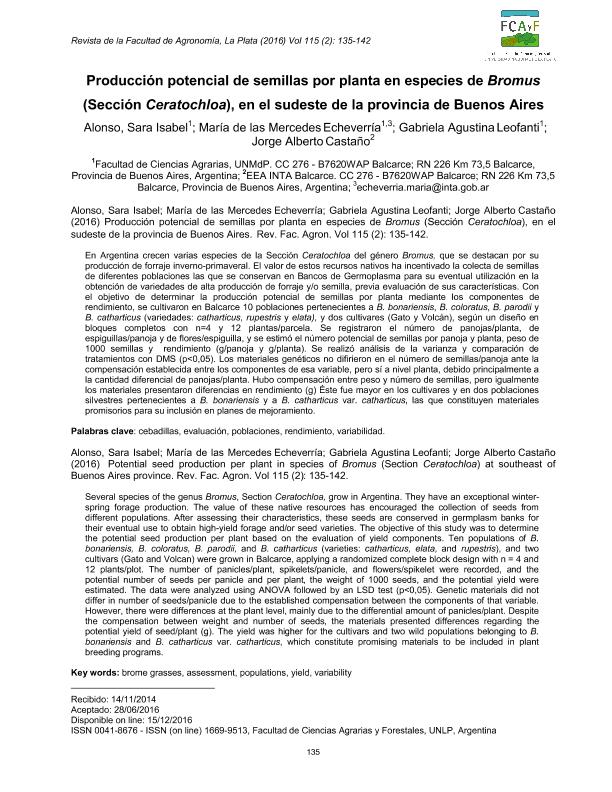Artículo
En Argentina crecen varias especies de la Sección Ceratochloa del género Bromus,que se destacan por su producción de forraje inverno-primaveral. El valor de estos recursos nativos ha incentivado la colecta de semillasde diferentes poblaciones las que se conservan en Bancos de Germoplasma para su eventual utilización en la obtención devariedades de alta producción de forraje y/o semilla, previaevaluación de sus características. Con el objetivo de determinar la producción potencial de semillas por planta mediante los componentes de rendimiento, se cultivaron en Balcarce 10 poblaciones pertenecientes a B.bonariensis, B.coloratus, B.parodii y B.catharticus (variedades: catharticus,rupestrisy elata), y dos cultivares (Gato y Volcán), según un diseño en bloques completos con n=4 y 12 plantas/parcela. Se registró el número de panojas/planta,de espiguillas/panoja y de flores/espiguilla, y se estimó el número potencial de semillas por panoja y planta, peso de 1000 semillas yrendimiento (g/panoja y g/planta). Se realizó análisis de la varianza y comparación de tratamientos con DMS (p<0,05). Se detectó variabilidad significativa para varios atributos. Los materiales genéticos no difirieron en el número de semillas/panoja ante la compensación establecida entre sus componentes, pero sí a nivel planta, debido principalmente a la cantidad diferencial de panojas/planta. Hubo compensación entre peso y número de semillas, pero igualmente los materiales presentaron diferencias en rendimiento de semillas por planta. Éste fue mayor en los cultivares y en dos poblaciones silvestres pertenecientes a B.bonariensis y a B. catharticus var.catharticus, las que podrían considerarse materiales promisorios para su inclusión en planes de mejoramiento. Several species of the genus Bromus, Section Ceratochloa, grow in Argentina. They have an exceptional winterspring forage production. The value of these native resources has encouraged the collection of seeds from different populations. After assessing their characteristics, these seeds are conserved in germplasm banks for their eventual use to obtain high-yield forage and/or seed varieties. The objective of this study was to determine the potential seed production per plant based on the evaluation of yield components. Ten populations of B. bonariensis, B. coloratus, B. parodii, and B. catharticus (varieties: catharticus, elata, and rupestris), and two cultivars (Gato and Volcan) were grown in Balcarce, applying a randomized complete block design with n = 4 and 12 plants/plot. The number of panicles/plant, spikelets/panicle, and flowers/spikelet were recorded, and the potential number of seeds per panicle and per plant, the weight of 1000 seeds, and the potential yield were estimated. The data were analyzed using ANOVA followed by an LSD test (p<0,05). Genetic materials did not differ in number of seeds/panicle due to the established compensation between the components of that variable. However, there were differences at the plant level, mainly due to the differential amount of panicles/plant. Despite the compensation between weight and number of seeds, the materials presented differences regarding the potential yield of seed/plant (g). The yield was higher for the cultivars and two wild populations belonging to B. bonariensis and B. catharticus var. catharticus, which constitute promising materials to be included in plant breeding programs.
Producción potencial de semillas por planta en especies de Bromus (Sección Ceratochloa), en el sudeste de la provincia de Buenos Aires
Alonso, Sara Isabel; Echeverria, María de Las Mercedes; Leofanti, Gabriela Agustina ; Castaño, Jorge Alberto
; Castaño, Jorge Alberto
 ; Castaño, Jorge Alberto
; Castaño, Jorge Alberto
Fecha de publicación:
12/2016
Editorial:
Universidad Nacional de la Plata. Facultad de Ciencias Agrarias y Forestales
Revista:
Revista de la Facultad de Agronomía
e-ISSN:
1669-9513
Idioma:
Español
Tipo de recurso:
Artículo publicado
Clasificación temática:
Resumen
Palabras clave:
CEBADILLAS
,
EVALUACION
,
POBLACIONES
,
RENDIMIENTO
,
VARIABILIDAD
Archivos asociados
Licencia
Identificadores
Colecciones
Articulos(CCT - MAR DEL PLATA)
Articulos de CTRO.CIENTIFICO TECNOL.CONICET - MAR DEL PLATA
Articulos de CTRO.CIENTIFICO TECNOL.CONICET - MAR DEL PLATA
Citación
Alonso, Sara Isabel; Echeverria, María de Las Mercedes; Leofanti, Gabriela Agustina; Castaño, Jorge Alberto; Producción potencial de semillas por planta en especies de Bromus (Sección Ceratochloa), en el sudeste de la provincia de Buenos Aires; Universidad Nacional de la Plata. Facultad de Ciencias Agrarias y Forestales; Revista de la Facultad de Agronomía; 115; 2; 12-2016; 147-154
Compartir



